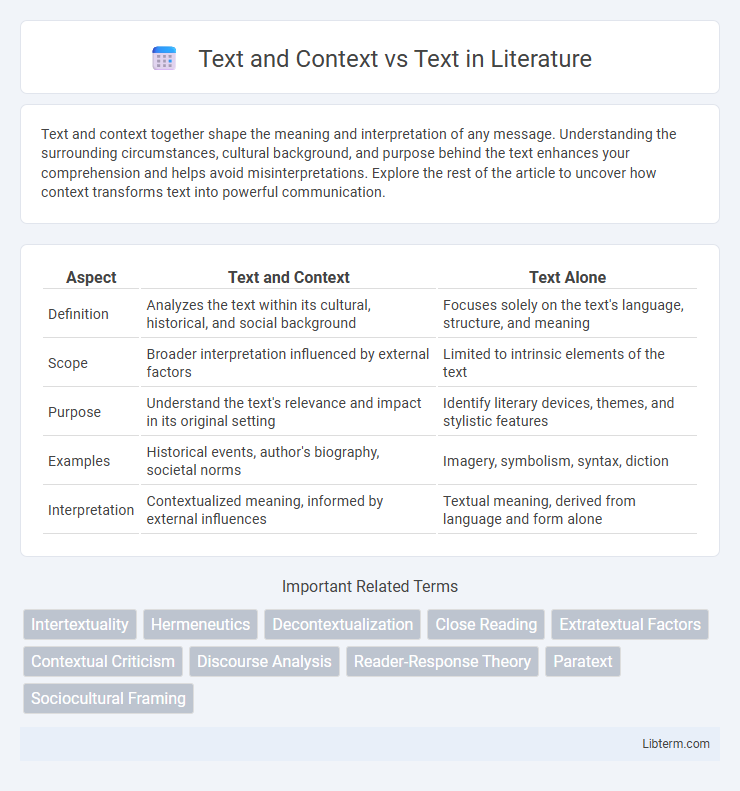Text and context together shape the meaning and interpretation of any message. Understanding the surrounding circumstances, cultural background, and purpose behind the text enhances your comprehension and helps avoid misinterpretations. Explore the rest of the article to uncover how context transforms text into powerful communication.
Table of Comparison
| Aspect | Text and Context | Text Alone |
|---|---|---|
| Definition | Analyzes the text within its cultural, historical, and social background | Focuses solely on the text's language, structure, and meaning |
| Scope | Broader interpretation influenced by external factors | Limited to intrinsic elements of the text |
| Purpose | Understand the text's relevance and impact in its original setting | Identify literary devices, themes, and stylistic features |
| Examples | Historical events, author's biography, societal norms | Imagery, symbolism, syntax, diction |
| Interpretation | Contextualized meaning, informed by external influences | Textual meaning, derived from language and form alone |
Introduction to Text and Context
Text and Context examines how meaning is shaped not only by the written or spoken words but also by the surrounding circumstances, cultural background, and situational factors that influence interpretation. Understanding context enhances comprehension by revealing implicit nuances, intentions, and relevance embedded within the text. This analysis is essential for accurate communication, critical reading, and effective textual analysis.
Defining "Text" in Literary Studies
Defining "text" in literary studies involves recognizing it as any written, spoken, or visual work subject to interpretation, ranging from traditional literature to multimedia artifacts. Texts serve as carriers of meaning that require contextual analysis to uncover deeper significance, emphasizing the interplay between language, culture, and reader response. Understanding "text" extends beyond the isolated words to include social, historical, and cultural contexts influencing interpretation and critical analysis.
What is "Context"?
Context refers to the surrounding circumstances, background, or environment in which a text exists, influencing its meaning and interpretation. It includes cultural, historical, social, and situational factors that shape how readers understand the text. Understanding context is essential for interpreting the text beyond its literal words, revealing deeper significance and intent.
Historical Perspectives on Text
Historical perspectives on text emphasize the dynamic interplay between text and its broader context, recognizing how cultural, political, and social factors shape textual meanings over time. Scholars highlight that understanding a text requires analyzing the historical conditions surrounding its creation and reception, as opposed to viewing it as an isolated artifact. This approach reveals how interpretations evolve and how texts function within larger discursive frameworks throughout history.
The Role of Context in Interpretation
Context plays a crucial role in interpreting text by providing the background information necessary to understand meaning beyond the literal words. Semantic nuances, cultural references, and situational factors shape how text is perceived and prevent misinterpretation. Analyzing text alongside its context enhances comprehension by revealing implied meanings, intentions, and relevance within specific discourse environments.
Textual Analysis: Isolating the Text
Textual analysis focusing solely on the text isolates linguistic elements such as syntax, semantics, and narrative structure without reference to external contexts like author intent, cultural background, or historical setting. This approach emphasizes close reading to uncover intrinsic meanings encoded within the text's language and form. It leverages literary theories such as New Criticism to rigorously analyze textual mechanics and rhetoric for inherent significance independent of external influences.
Contextual Analysis: Beyond the Words
Contextual analysis delves into the situational, cultural, and historical factors surrounding a text to uncover deeper meanings that words alone cannot convey. This approach emphasizes how external influences shape interpretation, revealing nuances and subtexts absent in isolated textual analysis. Understanding the interplay between text and context enhances semantic comprehension, enriching both literary and communication studies.
Major Theories: Text vs. Context Approaches
Major theories in "Text and Context" emphasize the dynamic interaction between linguistic elements and situational factors, arguing that meaning derives from both the text itself and its contextual environment. In contrast, "Text" approaches prioritize the intrinsic features of the text, such as structure, syntax, and semantics, often adopting a formalist or structuralist perspective that isolates the text from external influences. Key semantic theories, including Pragmatics and Speech Act Theory, support the "Text and Context" approach by highlighting how context shapes interpretation, while Structuralism and Formalism underpin the "Text" approach by focusing on internal textual coherence and meaning.
Case Studies: Text Alone vs. Text with Context
Case studies comparing text alone versus text with context reveal that incorporating contextual information significantly enhances comprehension and user engagement. Text accompanied by relevant context enables deeper semantic understanding, reducing ambiguity and improving the accuracy of interpretations in applications such as natural language processing and information retrieval. Empirical research demonstrates that context-aware models outperform text-only models in tasks like sentiment analysis, question answering, and machine translation.
Conclusion: Integrating Text and Context
Integrating text and context enhances comprehension by combining linguistic information with situational cues, allowing for more accurate interpretation of meaning. Purely text-based analysis often misses nuances that context provides, such as tone, intent, and cultural references. Therefore, leveraging both text and context leads to richer insights, improved natural language understanding, and more effective communication models.
Text and Context Infographic

 libterm.com
libterm.com